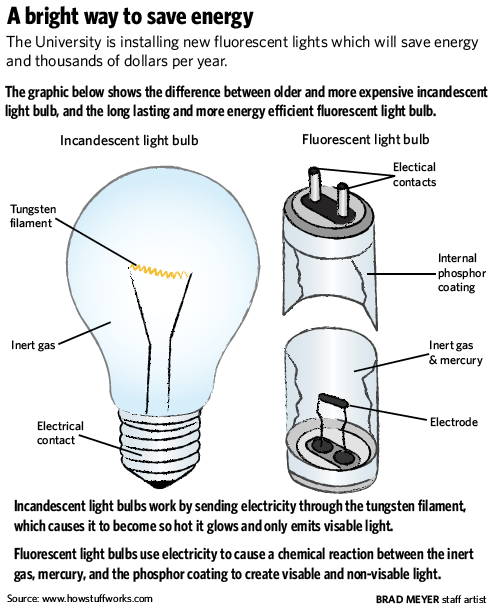University funds project to replace old light bulbs
Sep 9, 2008
Last updated on May 13, 2016 at 01:42 p.m.
How many light bulbs does it take to change a campus?
At the University, it could be around 1 million bulbs, give or take a few sockets.
A $2.8 million project is under way to replace outmoded lights in 44 buildings around campus. Officials hope new, efficient fluorescent lamps will save the University more than $1 million a year in energy costs. But for now, the University is catching up to other schools that have already transitioned to the new technology.
“Any building built between 1930 and 1990 has inefficient fluorescent lights,” said Eva Sweeney, an engineering specialist with Facilities and Services. “It’s better late than never.”
Get The Daily Illini in your inbox!
Over the summer, new lights were installed in the English Building, the National Soybean Research Center, the Psychology Building and Turner Hall. The annual savings from those four buildings alone is expected to top $80,000, Sweeney said. But the old technology is more than a financial liability – the older lights also pose safety concerns.
Private contractors are removing the lights, some of which contain chemicals called polychlorinated biphenyls, which are highly toxic if exposed through leaks or fire. A report by the Environmental Protection Agency recommends schools remove fluorescent fixtures installed before 1979.
While the newer lamps also contain mercury, a chemical essential for fluorescent lamps, Sweeney said it is present in safe amounts and will be handled carefully during installation.
“We don’t think we can do this all right away,” Sweeney said. “We have the older-style lights in many buildings. “The ones that are older, we are glad to get off the campus.”
One difference between the new and old fluorescent lamps involves the ballast, or the device that keeps current running through the lamp. The ballasts on older “T12”-style lamps are made with magnets, but newer “T8” models use more efficient electronic devices.
Other schools, including the University of Wisconsin and University of Michigan, caught on to the new technology earlier in the decade. Faramarz Vakili, associate director of facilities planning and management at the University of Wisconsin, said the school is almost done with its upgrade and is already seeing benefits.
“We have pretty much changed everything from T12 to T8 lighting, which has conserved us a lot of energy,” Vakill said. “Over 95 percent of our lighting is upgrading now.”
There is a demand for more efficient lighting outside classrooms as well. New fluorescent lights installed in the Ice Arena over the summer are expected to save more than $8,000 per year, Sweeney said.
Assembly Hall is also in the early stages of a similar operation. The 45-year-old building is receiving motion-sensor lights around concourses and bathrooms to reduce energy use. The arena still has its original main lighting system, but Assembly Hall Director Kevin Ullestad said newer arenas have access to different technology.
“We’ve been upgrading to more efficient lighting, although we haven’t approached the issue of inside lights,” Ullestad said.
The project has implications for energy usage around campus. Although the 44 buildings slated to receive the new lights house just a fraction of the 1 million-plus light bulbs on campus, the new lights in those locations would still save 1.1 million kilowatt hours of electricity per year.
While no residence halls are scheduled to receive the new lights, Sweeney said the project still represents a cost-efficient way to maintain the campus.
“We have a huge deferred maintenance backlog, so this might get two birds with one stone,” Sweeney said.






